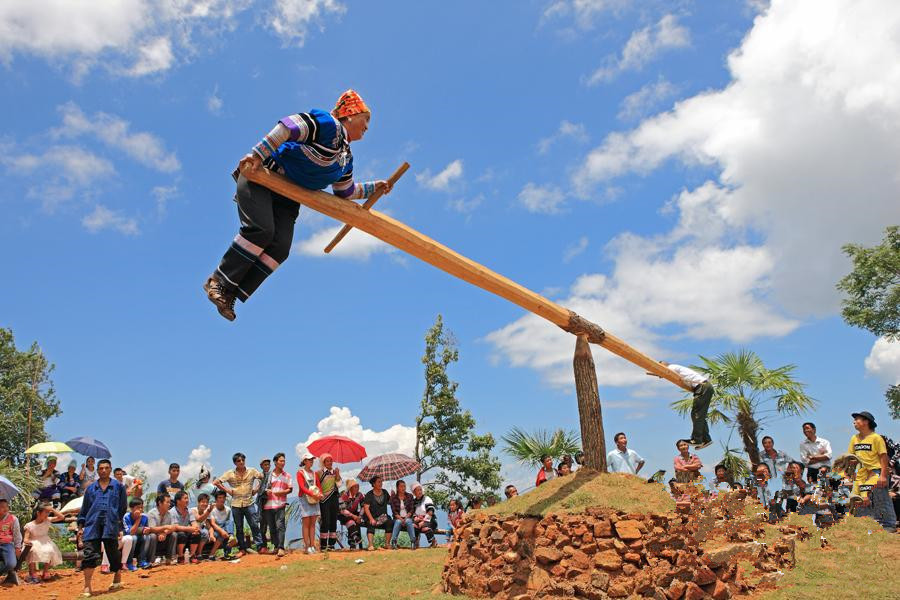 alt="Market Days in Menglian and Townships, Puer"
/>
alt="Market Days in Menglian and Townships, Puer"
/>
Kuzhazha Festival (Liuyuenian) of Hani Ethnic Minority
Basic Introduction
Chinese Name: 哈尼族苦扎扎节
English Name: Kuzhazha Festival (Liuyuenian) of Hani Ethnic Minority
The Ku Zhazha Festival, also known as the “June Year,” is celebrated in mid-June every year according to the lunar calendar. It is a grand traditional festival of the Hani people in Honghe, and it is as lively and grand as the Spring Festival celebrated by the Han ethnic group.
Elderly people gather in the open space to drink and have fun, while children chase each other and play. Young people form circles to perform traditional dances such as the fan dance, bamboo pole dance, and music and dance performances. The sounds of gongs and drums, the strings of musical instruments, and cheers interweave and echo through the mountains, marking the beginning of an all-night celebration.
The Ku Zhazha Festival, also known as the “June Year,” is celebrated in mid-June every year according to the lunar calendar. It is a grand traditional festival of the Hani people in Honghe, lively and grand like the Spring Festival celebrated by the Han ethnic group. During this time, Hani villages are filled with excitement and bustling energy. People dress in colorful festive attire and gather in groups at the celebration grounds to enjoy games and entertainment, joyfully celebrating the festival.
Festival Customs
According to Hani customs, the autumn grinding pole must be cut down at night, and young men carry it back before dawn. They sing mountain songs as they transport the hard and durable wooden pole to the festival grounds at the edge of the village. They plant one end of the pole into the ground, tapering the top to create an axis, and then hollow out the long horizontal pole to place on top. The horizontal beams on both sides must be of equal length and smoothed out to prevent injuries.

In the afternoon, Hani people dressed in vibrant clothing gather closely at the grinding ground. Following the Hani tradition of respecting elders, a few respected elders begin the grinding ceremony. After symbolically throwing the pole a few times, pairs of young men and women take turns to spin. The autumn grinding is a fun athletic activity for the Hani people, requiring equal numbers on both sides. Those riding on the pole push off the ground with their feet, sometimes spinning rapidly and sometimes rising and falling, rotating back and forth. As the pole swing speeds up, the spectators become increasingly joyful, occasionally shouting “Oh ho ho, oh ho ho!” to cheer, creating a lively atmosphere. The skilled and daring young men often become the objects of admiration for the young women.

As the sun sets, a series of clear gunshots sound from the grinding ground, signaling people to come and sing and dance. Young couples who had hidden in the woods to flirt gather together, and older people and children also arrive. The elders sit together to drink and enjoy themselves, children chase each other and play, while young people form circles to perform fan dances, bamboo pole dances, and musical performances. The sounds of gongs and drums, the strings of instruments, and cheers intertwine and echo through the mountains, marking the beginning of an all-night celebration.

 7 Days GolfingTour
7 Days GolfingTour
 8 Days Group Tour
8 Days Group Tour
 8 Days Yunnan Tour
8 Days Yunnan Tour
 7 Days Shangri La Hiking
7 Days Shangri La Hiking
 11 Days Yunnan Tour
11 Days Yunnan Tour
 6 Days Yuanyang Terraces
6 Days Yuanyang Terraces
 11 Days Yunnan Tour
11 Days Yunnan Tour
 8 Days South Yunnan
8 Days South Yunnan
 7 Days Tea Tour
7 Days Tea Tour
 8 Days Muslim Tour
8 Days Muslim Tour
 12 Days Self-Driving
12 Days Self-Driving
 4 Days Haba Climbing
4 Days Haba Climbing
 Tiger Leaping Gorge
Tiger Leaping Gorge
 Stone Forest
Stone Forest
 Yunnan-Tibet
Yunnan-Tibet
 Hani Rice Terraces
Hani Rice Terraces
 Kunming
Kunming
 Lijiang
Lijiang
 Shangri-la
Shangri-la
 Dali
Dali
 XishuangBanna
XishuangBanna
 Honghe
Honghe
 Kunming
Kunming
 Lijiang
Lijiang
 Shangri-la
Shangri-la
 Yuanyang Rice Terraces
Yuanyang Rice Terraces
 Nujiang
Nujiang
 XishuangBanna
XishuangBanna
 Spring City Golf
Spring City Golf
 Snow Mountain Golf
Snow Mountain Golf
 Stone Mountain Golf
Stone Mountain Golf












 What Our Customers Say?
What Our Customers Say?
